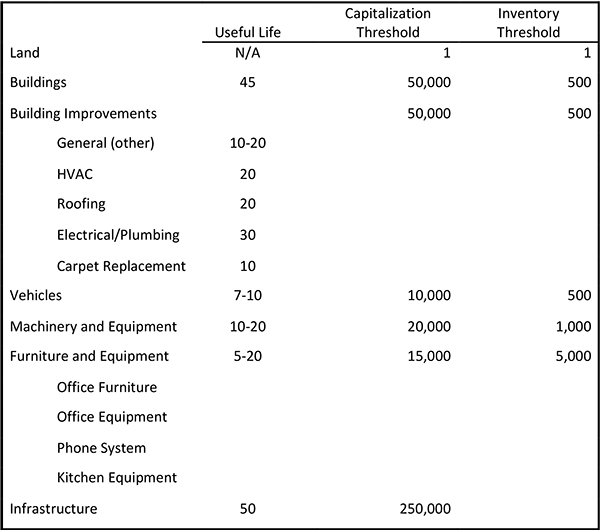The Board of Trustees may modify, amend or supplement this policy, as it deems necessary and appropriate.
The purpose of this capital asset policy is to provide control and accountability over capital assets, and to gather and maintain information needed for the preparation of financial statements. The Fountaindale Public Library District capital asset policy is herein established to safeguard assets and to insure compliance with GASB34 for governmental financial reporting.
This policy is herein established to safeguard and address the Fountaindale Public Library District’s investment in property, which comprises a significant resource. This policy is meant to ensure compliance with various accounting and financial reporting standards including Generally Accepted Accounting Principles (GAAP), and Governmental Accounting, Auditing, and Financial Reporting (GAAFR).
Further, this policy is meant to reflect the Fountaindale Public Library District’s desire to meet the reporting requirements set forth in the Governmental Accounting Standards Board (GASB) Statement No. 34. Specifically, the GASB Statement No. 34 states that governments should provide additional disclosures in their summary of significant accounting policies including the policy for capitalizing assets and for estimating the useful lives of those assets which is used to calculate the depreciation expense. The Statement also requires disclosure of major classes of assets, beginning and end-of-year balances, capital acquisition, sales/dispositions, and current-period depreciation expense.
Responsibility for control of capital assets will rest with the operating department wherein the asset is located. The Finance Department shall ensure that such control is maintained by establishing an inclusive capital asset inventory schedule. Asset purchases, which fall below the capitalization threshold, will not be included in the capital asset inventory.
Each Department will be responsible for control of capital assets for their department. The Department Head shall ensure that such control is maintained by updating the capital asset inventory schedule created by the Finance Department. The inventory schedule will include the following for each asset:
This list will be maintained, updated, and reviewed by the Department Head and given to the Finance Department on an ongoing basis.
Capital assets should be valued at cost or historical costs, plus those costs necessary to place the asset in its location (i.e. freight, installation charges.) In the absence of historical costs information, a realistic estimate will be used. Donated assets will be recorded at the estimated current fair market value.
When to Capitalize Assets:
Assets are capitalized at the time of acquisition. To be considered a capital asset for financial reporting purposes an item must be at or above the capitalization threshold and have a useful life of at least one year.
Assets not Capitalized:
Capital assets below the capitalization threshold on a unit basis and above $500 but warranting “control” shall be inventoried at the department level and an appropriate list will be maintained and reported to the Finance Department.
Capital Assets should be capitalized if they meet the following criteria:
Capital Assets include the following major classes of assets:
Land and Land Improvements – Capitalized value is to include the purchases price plus costs such as legal fees and filing fees; improvements such as parking lots, fences, pedestrian bridges, landscaping.
Building and Building Improvements – Costs include purchase price plus costs such as legal fees and filing fees; improvements include structures and all other property permanently attached to, or an integral part of the structure. These costs include re-roofing, electrical/plumbing, carpet replacement, and HVAC.
Vehicles – Costs include purchase price plus costs such as title & registration.
Machinery and Equipment – Assets included in this category are heavy equipment, traffic equipment, generators, office equipment; phone system, and kitchen equipment.
Infrastructure Assets – Infrastructure Assets are long-lived capital assets that are stationary in nature and normally can be preserved for a significantly greater number of years than most capital assets.
Furniture & Fixtures – FF&E are movable furniture, fixtures, or other equipment that have no permanent connection to the structure of a building or utilities. These items depreciate substantially but definitely are important costs to consider when valuing a company, especially in liquidation.
Depreciation is computed on a straight-line method computed on an annual basis over the asset’s assigned useful life. Assets will be depreciated using the half-year convention in the year of acquisition. This means that only half of the full-year depreciation is allowed in the first year, with the remaining balance being deducted the final year of the assets useful life. Additions and improvements will only be capitalized if the cost either enhances the asset’s functionality or extends the asset’s useful life.
Projects in process will be added to the asset base as the projected expenses are incurred. However, the project will first need to meet its individual threshold.

Capital assets are to be removed from inventory once they are obsolete or claimed as surplus property. The item must be removed from the department inventory listing and reported to the Finance Department.
Each Department must add additions and deletions from donated or transferred assets to the inventory listing.
Each Department must report all capital assets classified as surplus to the finance department.
When suspected or known losses of inventoried assets occur, the Department should conduct a search for the missing property. The search should include transfer to another department, storage, scrapping, surplus property. If the missing property is not found, the department must contact the Finance Department.
